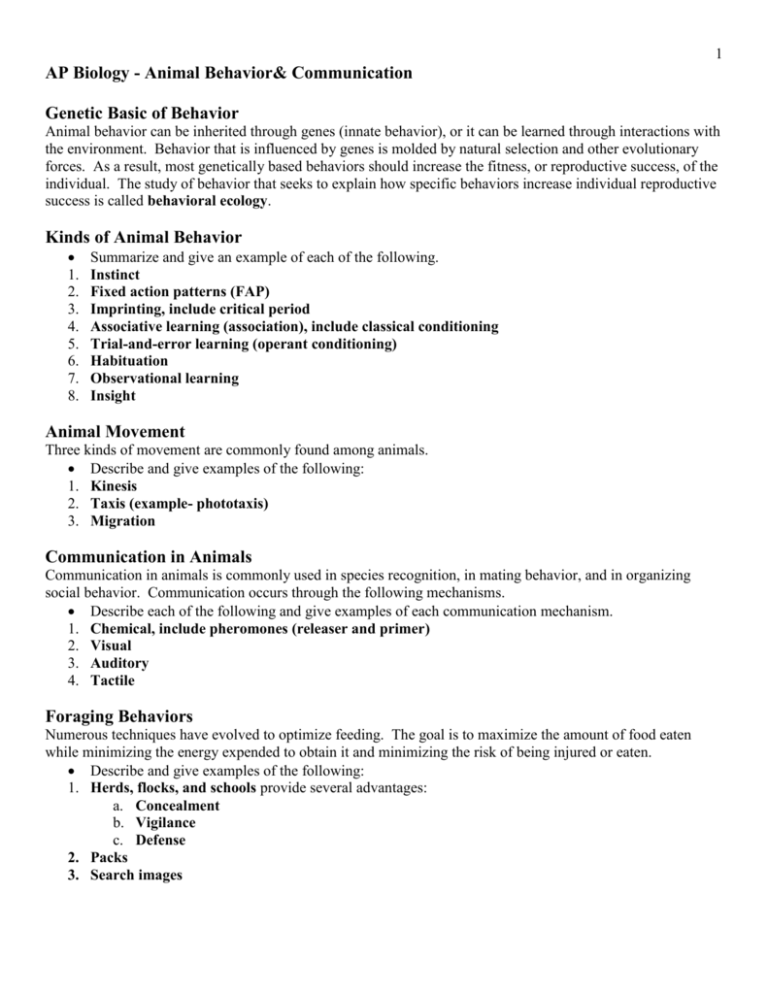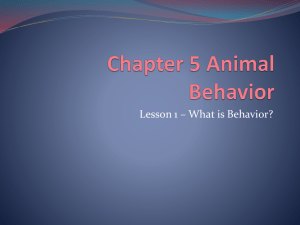AP Biology - Animal Behavior& Communication
advertisement

1 AP Biology - Animal Behavior& Communication Genetic Basic of Behavior Animal behavior can be inherited through genes (innate behavior), or it can be learned through interactions with the environment. Behavior that is influenced by genes is molded by natural selection and other evolutionary forces. As a result, most genetically based behaviors should increase the fitness, or reproductive success, of the individual. The study of behavior that seeks to explain how specific behaviors increase individual reproductive success is called behavioral ecology. Kinds of Animal Behavior 1. 2. 3. 4. 5. 6. 7. 8. Summarize and give an example of each of the following. Instinct Fixed action patterns (FAP) Imprinting, include critical period Associative learning (association), include classical conditioning Trial-and-error learning (operant conditioning) Habituation Observational learning Insight Animal Movement Three kinds of movement are commonly found among animals. Describe and give examples of the following: 1. Kinesis 2. Taxis (example- phototaxis) 3. Migration Communication in Animals Communication in animals is commonly used in species recognition, in mating behavior, and in organizing social behavior. Communication occurs through the following mechanisms. Describe each of the following and give examples of each communication mechanism. 1. Chemical, include pheromones (releaser and primer) 2. Visual 3. Auditory 4. Tactile Foraging Behaviors Numerous techniques have evolved to optimize feeding. The goal is to maximize the amount of food eaten while minimizing the energy expended to obtain it and minimizing the risk of being injured or eaten. Describe and give examples of the following: 1. Herds, flocks, and schools provide several advantages: a. Concealment b. Vigilance c. Defense 2. Packs 3. Search images 2 Social Behavior Animals may live in groups or they may be solitary. Sooner or later, however, all animals must make contact with others to reproduce. In each animal species, social behaviors have evolved that optimize individual fitness. Describe the following patterns of interactions: 1. 2. 3. 4. Agonistic behavior (aggression and submission) Dominance hierarchies, include pecking order Territoriality Altruistic behavior Essay Question #1 - Answer the following essay question. Define and explain how each of the following contributes to social behavior a. Pecking order b. Territoriality c. Traveling in herds or packs d. Altruistic behavior Essay Question #2 - Answer the following essay question. Describe each of the following animal behaviors as revealed in studies performed by the given researcher. a. Fixed action patterns and Nikolaas Tinbergen b. Imprinting and Konard Lorenz c. Classical conditioning and Ivan Pavlov d. Bee communication and Karl von Frisch NAME THAT BEHAVIOR! Create a concept map of animal behavior and communication by identifying the behavior/communication pictures on the powerpoint slides. After you have identified the pictures, cut out the pictures and create a concept map which includes the following: Title Creative concept map organization Identification labels Connector or transition words as necessary Replace one of the pictures you identified with a picture of you displaying the same behavior/communication. Include on the concept map. 3 Plant Hormones & Movement The growth and development of plants are controlled by substances known as hormones. There are five classes of plant hormones, which affect division, elongation, and cell differentiation. Complete the following chart: Functions of Plant Hormones Hormone Function Location in Plant Auxin Cytokinins Gibberellins Abscisic acid Ethylene Plant Movements 1. Define tropism: 2. Describe and draw the following: Phototropism Gravitropism Thigmotropism 3. Describe photoperiodism, include phytochrome, Pr and Pfr, red light, far red light.




